
Concept explainers
(a)
Interpretation:
The complete, detailed mechanism for the reaction is to be provided. The stereochemistry of the products is to be predicted where appropriate. If the reaction yields exclusively one product or a mixture of products, then the major product is to be determined.
Concept introduction:
For the prediction of the outcome of the
Answer to Problem 9.64P
The complete, detailed mechanism for the reaction is shown below:

Explanation of Solution
The given reaction is
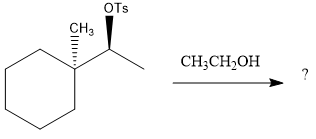
The absolute configuration of the substrate is S. This is solvolysis reaction because ethanol acts as a nucleophile and a solvent. The leaving group,
The attacking species
The loss of the leaving group,

A tertiary carbocation is highest stability than a secondary and primary carbocation. Next,

Now, the weak nucleophile,
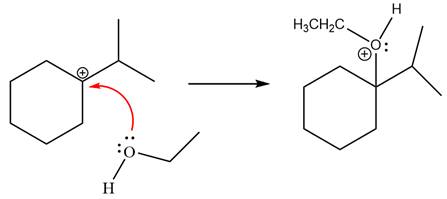
Finally, deprotonation of the
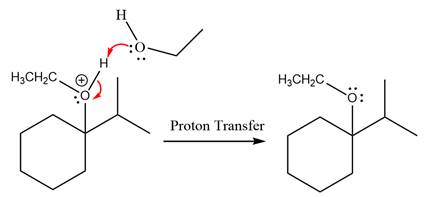
The detailed, complete mechanism is as follows:

The outcome of the given reaction is predicted by considering factors like the nature of the leaving group, substrate, the strength of the reagent used, solvent, and temperature.
(b)
Interpretation:
The complete, detailed mechanism for the reaction is to be provided. The stereochemistry of the products is to be predicted where appropriate. If the reaction yields exclusively one product or a mixture of products, then the major product is to be determined.
Concept introduction:
For the prediction of the outcome of the
Answer to Problem 9.64P
The complete, detailed mechanism for the reaction is shown below:
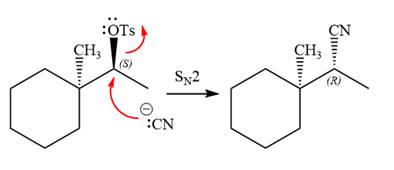
The stereochemistry of the product is R configuration.
Explanation of Solution
The given reaction is
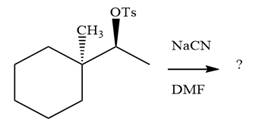
The absolute configuration of the substrate is S. The leaving group,
The attacking species
The carbon atom attached to the leaving group is a chiral center.
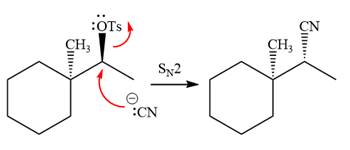
The stereochemistry of the product is R configuration.

The outcome of the given reaction is predicted by considering factors like the nature of the leaving group, substrate, the strength of the reagent used, solvent, and temperature.
(c)
Interpretation:
The complete, detailed mechanism for the reaction is to be provided. The stereochemistry of the products is to be predicted where appropriate. If the reaction yields exclusively one product or a mixture of products, then the major product is to be determined.
Concept introduction:
For the prediction of the outcome of the
Answer to Problem 9.64P
The complete, detailed mechanism for the reaction is shown below:

Explanation of Solution
The given reaction is
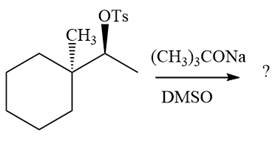
The absolute configuration of the substrate is S. The leaving group,
The attacking species
In the substrate, the alpha C atom has one H atom attached to it. Since

The outcome of the given reaction is predicted by considering factors like the nature of the leaving group, substrate, the strength of the reagent used, solvent, and temperature.
(d)
Interpretation:
The complete, detailed mechanism for the reaction is to be provided. The stereochemistry of the products is to be predicted where appropriate. If the reaction yields exclusively one product or a mixture of products, then the major product is to be determined.
Concept introduction:
For the prediction of the outcome of the
Answer to Problem 9.64P
The complete, detailed mechanism for the reaction is shown below:

Explanation of Solution
The given reaction is

The absolute configuration of the substrate is S. The leaving group,
The attacking species
The loss of the leaving group,

A tertiary carbocation is greatest stability than a secondary and primary carbocation. Next,

Now, the weak nucleophile
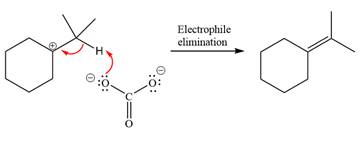
The detailed, complete mechanism is as follows:

The outcome of the given reaction is predicted by considering factors like the nature of the leaving group, substrate, the strength of the reagent used, solvent, and temperature.
(e)
Interpretation:
The complete, detailed mechanism for the reaction is to be provided. The stereochemistry of the products is to be predicted where appropriate. If the reaction yields exclusively one product or a mixture of products, then the major product is to be determined.
Concept introduction:
For the prediction of the outcome of the
Answer to Problem 9.64P
The complete, detailed mechanism for the reaction is shown below:

Explanation of Solution
The given reaction is

This is a solvolysis reaction because ethanol acts as a nucleophile and the solvent. The leaving group,
The attacking species
The loss of the leaving group,

Now, the weak nucleophile

The detailed, complete mechanism is as follows:

The outcome of the given reaction is predicted by considering factors like the nature of the leaving group, substrate, the strength of the reagent used, solvent, and temperature.
(f)
Interpretation:
The complete, detailed mechanism for the reaction is to be provided. The stereochemistry of the products is to be predicted where appropriate. If the reaction yields exclusively one product or a mixture of products, then the major product is to be determined.
Concept introduction:
For the prediction of the outcome of the
Answer to Problem 9.64P
The complete, detailed mechanism for the reaction is shown below:

Explanation of Solution
The given reaction is
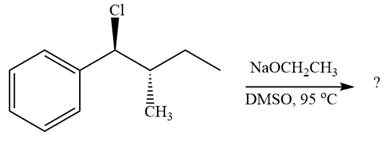
The leaving group,
The attacking species
In the substrate, only one H atom can be eliminated. The leaving group and H atom are on same side.

The base deprotonates a hydrogen atom from the substrate and to yield the most substituted alkene as the product.
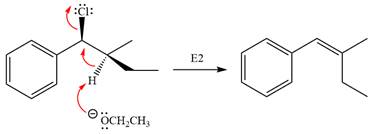
The detailed, complete mechanism is as follows:

The outcome of the given reaction is predicted by considering factors like the nature of the leaving group, substrate, the strength of the reagent used, solvent, and temperature.
Want to see more full solutions like this?
Chapter 9 Solutions
ORG CHEM W/ EBOOK & SW5 + STUDY GUIDE
- Draw the product of the reaction shown below. Ignore small byproducts that would evaporate pleasearrow_forwardPoly(ethylene adipate) is a biodegradable polyester (shown below). Identify the type of polymerization process used in the production of this polymer.arrow_forwardPolymers may be composed of thousands of monomers. draw two repeat units(dimer) of the polymer formed in this reaction. assume there are hydrogen atoms on the two ends of the dimer. ignore inorganic byproducts pleasearrow_forward
- Draw the product of the reaction shown below. Use a dash or wedge bond to indicate stereochemistry of substituents on asymmetric centers, Ignore inorganic byproductsarrow_forwardDraw the product of this reaction please. Ignore inorganic byproductsarrow_forwardOne of the pi molecular orbitals of 1,3-butadiene (CH2=CHCH=CH2) is shown below. Please identify the number of nodal planes perpendicular to the bonding axisarrow_forward
- Draw the monomers required to synthesize this condensation polymer please.arrow_forwardProvide the correct systematic name for the compound shown here. Please take into account the keyboard options belowarrow_forwardcurved arrows are used to illustrate the flow of electrons. using the provided starting and product structures, draw the curved electron-pushing arrows for the following reaction or mechanistic step(s)arrow_forward
- Identify the 'cartoon' drawing of the acceptor orbital in the first mechanistic step of an electrophilic addition reaction of butadiene with HBr. Pleasearrow_forwardH- H H H H H H Identify and select all structures below that represent a constitutional isomer(s) of the compound shown above. H- H H H A. H H H H-C CI H H D. H H H H H H C C -H H C C H H H H B. H CI H H- C C H H H H E. H CI H C.arrow_forwardWhy doesn't this carry on to form a ring by deprotonating the alpha carbon and the negatively-charged carbon attacking the C=O?arrow_forward
 Organic Chemistry: A Guided InquiryChemistryISBN:9780618974122Author:Andrei StraumanisPublisher:Cengage Learning
Organic Chemistry: A Guided InquiryChemistryISBN:9780618974122Author:Andrei StraumanisPublisher:Cengage Learning

